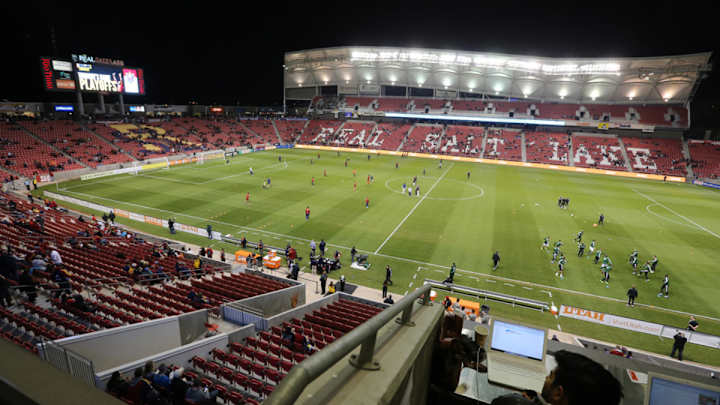How Rio Tinto Stadium, Olympic qualifying host, stays ready in the cold

Dan Farnes has his Kentucky Bluegrass field doing just swell considering the time of year. But the director of fields and grounds for Real Salt Lake has a little help, with an under-field vacuum and heating system at Rio Tinto Stadium offering him an assist to get ready for a slate of October Olympic qualifying games that, fortunately for him and the USA, Mexico, Honduras and Canada players, shouldn't have to endure cold weather. He's ready, though, in the event the forecast turns and for RSL's home stretch and MLS playoff push.
“It all depends on the weather, really,” he tells SI.com about fall games. “The last couple of years we have had a pretty mild winter, so it hasn’t been an issue. But it looks like everyone is predicting a rough winter.”
When the temperature drops, the grass slows its growing. Slower growing grass makes for a longer recovery time between games, not an ideal situation in a fall that can pile on the cleat-tearing stress. That’s why Farnes, a member of the Sport Turf Managers Association, fires up his subair system.
The system, which allows Rio Tinto to keep natural turf alive long enough—and early enough in the spring—to retain natural grass instead of artificial turf, sucks air from the outside and heats it in a room at the stadium, forcing the air through a series of tubes and pipes under the field. The warm air warms the soil from underneath.
Olympic qualifying semi, CONCACAF Cup determines future of U.S. U-23s
“It is not a quick fix,” Farnes cautions. “I can’t just turn it on, it takes quite a bit of planning. If the weather is forecasting snow for gameday (on a Saturday), I would have to turn it on Monday to get it warmed up enough to be effective.”
Farnes fires the system up, usually in October, to warm the air pushed through the popes to between 95 and 100 degrees.
He’ll leave it on for a week at a time. Any longer and he’ll start to “get nervous” about burning the roots.
“It is really important for us with our climate,” Farnes says. “If the team is going to be making the playoffs, they run until November and the finals is in December. The season starts at the end of February and we definitely have snow at the end of February. If we are making the playoffs, there are just a few months off.”
Jordan Morris, Jerome Kiesewetter spark USA’s shutout over Panama
Over trial and error for the past five years, Farnes has found the right mix of having the system on long enough to keep grass growing without burning it. And he uses grow tarps—clear tarps interwoven to allow water and sunlight through—to help support the system with a greenhouse effect that boosts the turf about 10 degrees. During snow, the system keeps the turf from freezing and can even melt a small amount of the wintry mix as it falls.
“The hope is—and it doesn’t always work out this way—to keep it around 60 degrees for the roots,” he says. “It is a balancing act to not burn the main pipe areas and still get (hot air) to smaller pipes on the field.”
Using all these different tools at Rio Tinto, Farnes and his crew of three other full-time workers keep natural grass growing in Utah. Even if a little turf trickery comes into play.
Tim Newcomb covers stadiums, sneakers and design at Sports Illustrated. Follow him on Twitter at @tdnewcomb.
